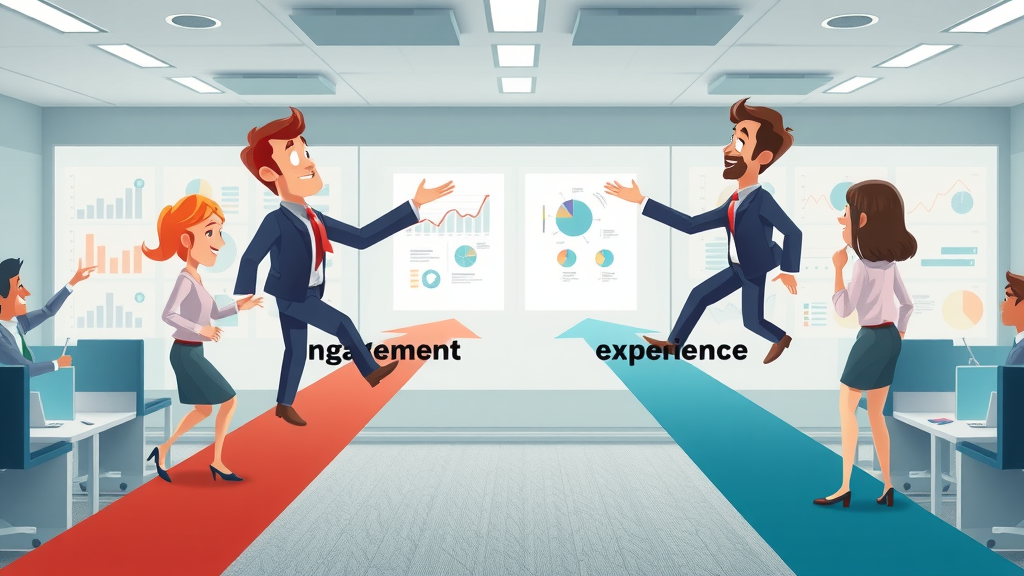Did you know that businesses with high customer engagement rates achieve up to 23% higher profitability? This striking statistic paints a clear picture—customer engagement isn’t a buzzword but a proven catalyst for business success. In today’s hyper-competitive landscape, organizations that prioritize building strong connections with their customers are the ones that consistently outperform the rest. If you’re ready to transform your business, dive in: discover simple, actionable tips to engage customers better, drive brand loyalty, and watch your results skyrocket.
Startling Insights: Why Customer Engagement is the Cornerstone of Modern Business Success
- Did you know that businesses with high customer engagement rates achieve up to 23% higher profitability? Discover why focusing on customer engagement can change your bottom line.

In the age of digital transformation, customer engagement sits at the heart of sustainable business growth. It’s not just about interacting with buyers; it’s about creating experiences that make customers feel valued and involved. High levels of customer engagement lead to repeat purchases, strong brand advocacy, and significantly higher profitability. Companies that invest in engagement strategies find their customers are more likely to share positive feedback, help reduce churn rate, and boost their overall brand experience. The bottom line? Focusing on customer engagement strategies delivers tangible business benefits worth pursuing.
Understanding Customer Engagement: Definitions and Key Concepts
What is Customer Engagement and Why Does it Matter?
- Defining customer engagement
- The link between customer engagement and customer satisfaction
- The impact on customer loyalty
"Customer engagement is the emotional connection between a customer and a brand—a crucial driver of long-term loyalty."

Customer engagement refers to the ongoing interaction between a brand and its customers, across multiple touchpoints and channels. It represents more than a simple transaction—it’s about building meaningful relationships that evoke emotional connections. Engaged customers feel heard and appreciated, which translates to higher customer satisfaction and, ultimately, stronger customer loyalty. By prioritizing customer engagement, businesses can turn one-time buyers into loyal advocates, ensuring their success in an ever-changing marketplace.
Strong customer engagement strategies build a solid foundation for cultivating trust and encouraging repeat business. When customers experience genuine interactions, they’re more likely to return, recommend, and feel invested in your brand’s mission. This deep connection results in increased retention and higher customer satisfaction , making it easier to sustain long-term business growth and reduce churn rate.
Exploring the Customer Journey for Enhanced Customer Engagement
- Mapping the customer journey
- Identifying key touchpoints that drive customer experience
- How engagement strategies shape the journey
Understanding the customer journey is a critical component of any successful customer engagement approach. By mapping out every potential interaction a customer has with your brand—from initial contact to post-purchase support—you gain a holistic view of how and where to engage most effectively. Identifying these key touchpoints allows businesses to strengthen every moment, making each interaction feel purposeful and personalized.
Engagement strategies designed around the customer journey can help deliver a seamless brand experience at every stage. For example, timely follow-ups, personalized recommendations, and proactive support all make customers feel valued and understood. Ultimately, tailoring your customer engagement strategy to support the journey increases satisfaction and builds trust throughout every phase.
The Difference Between Customer Engagement and Customer Experience
- Why customer experience is not the same as engagement
- The role of effective customer engagement in improving customer experiences

It’s easy to confuse customer engagement with customer experience , but they’re not interchangeable. Customer experience refers to the entire perception of your brand, from marketing campaigns to product delivery. Meanwhile, customer engagement is all about how customers interact with your brand—and how you nurture those interactions to foster deeper connections. In short, experience is the journey, while engagement is the active participation along the way.
Effective customer engagement can dramatically improve overall customer experiences. When businesses actively seek and respond to customer feedback , personalize communication, and reward loyal behaviors, they create memorable experiences that elevate the whole journey. A seamless blend of both—engagement and experience—results in customers who are not only satisfied, but delighted and inspired to remain loyal.
Customer Engagement Strategies that Deliver Results
Crafting a Winning Customer Engagement Strategy for Your Brand
- Establishing objectives for your engagement strategy
- Aligning customer engagement strategies with the brand mission
- Key elements for successful implementation
Developing a tailored customer engagement strategy begins with clear, achievable objectives. Ask yourself: What do you want your engagement efforts to accomplish? Objectives might include increasing brand loyalty, improving customer satisfaction scores, or strengthening customer relationships with existing customers. Align your engagement strategies with your core brand mission so that every interaction feels authentic and feeds into a unified brand experience.
Implementing a successful strategy requires careful planning and consistent execution. Start by identifying which customer touchpoints need attention—be it customer service, email marketing, social media, or loyalty programs. Incorporate customer feedback mechanisms and train your staff in effective customer engagement techniques. Regularly monitor progress and adapt your tactics as you learn more about your customers’ evolving needs and preferences.
Leveraging Customer Engagement Platforms to Maximize Results
- Features to look for in an engagement platform
- Integrating customer engagement platforms into your workflow
- Comparing top engagement platforms (Table included)

A robust customer engagement platform is key to scaling your efforts and driving measurable outcomes. The right tool empowers teams to track customer interactions in real-time, analyze engagement levels, and automate personalized messaging that resonates. Essential features to look for include workflow automation, omnichannel communication, advanced analytics, and easy integration with existing business systems.
Seamlessly integrating a customer engagement platform into your workflow fosters a 360-degree view of each customer. This integration streamlines support, enables data-driven decisions, and offers opportunities for personalized experiences that drive both retention and growth. Compare options carefully based on your industry, business size, and unique engagement needs.
| Platform | Core Features | Pricing | Pros | Cons |
|---|---|---|---|---|
| EngagePro | Omnichannel messaging, CRM integration, analytics dashboard | From $99/month | User-friendly, strong automation, excellent support | Limited integrations for niche tools |
| Loyalty360 | Loyalty rewards, survey tools, segmentation | Custom pricing | Great for brand loyalty building, customizable | Complex setup for beginners |
| SocialConnect | Social listening, campaign management, engagement tracking | From $49/month | Affordable, ideal for social media-driven brands | Reporting features can be expanded |
Social Media as a Customer Engagement Powerhouse
- Selecting the best channels for your audience
- Tips for authentic interaction
- Case study: Social media campaigns that drove exceptional customer engagement

Social media continues to be a game-changer for customer engagement, offering direct and rapid access to your target audience. The first step is selecting the right platforms—think Facebook, Instagram, LinkedIn, TikTok—based on where your existing and potential customers spend most of their time. Analyze your customer journey to discover their preferences, and focus resources on these high-impact channels.
Authentic interaction is paramount on social media. Respond promptly to comments, address concerns, and encourage user-generated content for meaningful engagement. One illustrative case study involves a retail brand leveraging Instagram Stories for daily behind-the-scenes peeks, generating a groundswell of engagement, positive customer feedback, and surges in direct purchases. Strategic and personal, these campaigns build real conversations that drive brand loyalty and memorable brand experiences.
Collecting and Acting on Customer Feedback for Improved Customer Engagement
- Methods for gathering actionable feedback
- Turning feedback into customer engagement opportunities
- Reducing churn rate and growing customer loyalty

Customer feedback is a goldmine for continuous improvement and deeper engagement. Collect feedback through surveys, review platforms, live chat interactions, and social media polls. Each touchpoint offers valuable insights into what’s working and where your engagement strategy could improve. By actively soliciting and thoughtfully reviewing feedback, your brand demonstrates a commitment to listening and evolving with its audience.
Successful brands don’t just collect feedback—they act on it. Using these insights, you can address customer pain points, launch targeted marketing campaigns, and refine workflows for a more personalized experience. These improvements reduce churn rate by showing customers their voices matter, strengthening trust and customer loyalty in the process.
Practical Tips to Improve Customer Engagement Instantly
- Personalize every customer interaction
- Reward and recognize customer loyalty
- Empower customer service teams for effective customer engagement
- Use marketing campaigns to nurture brand experience
To improve customer engagement quickly, begin by personalizing every touchpoint—use customer names, relevant purchase history, and tailored recommendations. Recognize and reward loyal customers with appreciation emails, discount offers, or exclusive access. Next, empower your customer service teams with training, so they resolve issues efficiently and sympathetically every time. Finally, turn your marketing campaigns into nurturing experiences that reinforce your brand’s values and keep you top-of-mind throughout the customer journey.
- 10 Simple Ways to Boost Customer Engagement Today
- Send personalized thank-you notes after purchases
- Launch a customer loyalty rewards program
- Respond promptly to reviews and feedback
- Host interactive live streams or Q&A sessions on social media
- Use surveys to understand customer needs
- Empower employees with engagement tools and training
- Surprise top customers with special offers
- Share customer stories in your marketing content
- Keep evolving your products/services based on feedback
- Celebrate customer milestones publicly (anniversaries, achievements)
"Engaged customers are not born, they're made through consistent, meaningful connections."
How to Foster Customer Relationships That Last
- Building trust step by step
- Sustaining communication with effective engagement strategies

Enduring customer relationships are built on trust and transparency. Develop trust by delivering on your promises, addressing customer issues proactively, and providing consistent value in every interaction. Simple acts—such as following up after a purchase or sending relevant content—help nurture these relationships over time.
Sustained communication is essential for keeping customer relationships alive. Regular check-ins, birthday greetings, and timely follow-ups can go a long way in showing customers they’re more than just a transaction. When customers feel seen and appreciated, they’re more likely to remain loyal, advocate for your brand, and remain engaged long after the initial sale.
Using Customer Data to Tailor Engagement Strategies
- Measuring customer behavior
- Adapting messaging for different customer segments
Modern businesses have access to a wealth of data, which can be leveraged to personalize and improve customer engagement . Track customer behavior—such as purchase history, browsing patterns, and interaction frequency—to understand what resonates most. Use this information to segment your audience and adapt messaging accordingly, ensuring each group receives relevant content and offers.
With tailored messaging, your engagement strategies become more effective. Personalized experiences signal to customers that you value them as individuals, not just numbers. Over time, this deepens loyalty and increases the likelihood that customers will actively engage and advocate for your brand.
Empowering Your Team for Effective Customer Service
- Training staff on customer interactions
- Encouraging a customer-first mindset across departments

Your team is the face of your customer engagement efforts. Investing in proper training ensures they have the tools and confidence to handle every customer interaction with empathy, efficiency, and enthusiasm. Empower teams to go above and beyond—from timely responses via customer service channels to crafting impactful follow-up messages.
Creating a company-wide, customer-first mindset is equally vital. When everyone, from sales to support, understands their role in engagement, positive experiences become the norm. This consistency helps build trust, strengthens customer relationships, and reinforces your brand’s reputation for delivering excellent customer service .
Case Studies: Real-World Customer Engagement Success Stories
- Brand A: How a customer engagement strategy increased retention by 40%
- Brand B: Innovative use of a customer engagement platform to build loyalty
"Our focus on customer engagement turned feedback into our greatest growth engine." — Successful Brand Leader

Brand A implemented a holistic customer engagement strategy centered around regular outreach, personalized offers, and proactive support. By mapping the customer journey and targeting key touchpoints, they boosted retention by an astounding 40%. Their approach included leveraging automated email campaigns, enriching customer interactions, and gathering ongoing feedback to drive continuous improvement.
Brand B adopted a leading customer engagement platform that unified all their communications and provided invaluable insights into customer sentiment. The result? They pioneered innovative loyalty programs, rewarded engaged customers with exclusive content, and increased advocacy. This investment not only accelerated brand loyalty but transformed the way both existing and new customers experienced the brand.
People Also Ask: Expert Answers on Customer Engagement
What is the meaning of customer engagement?
- Customer engagement refers to building and nurturing ongoing relationships with customers through meaningful interactions across various channels, resulting in increased satisfaction, loyalty, and advocacy.
What are the 3 C's of customer engagement?
- The 3 C's of customer engagement are: Connection (building rapport), Consistency (delivering a reliable experience), and Customization (tailoring interactions to specific needs).
What are the 4 P's of customer engagement?
- The 4 P's of customer engagement: Personalization, Proactiveness, Performance, and Participation—essential principles for impactful engagement strategies.
What are the 6 key elements of service in customer engagement?
- The 6 elements are: Understanding needs, Effective communication, Speedy response, Consistency, Personal touch, and Continuous improvement.

Crafting Your Customer Engagement Action Plan
- Setting measurable engagement goals
- Choosing the right engagement strategies and platforms
- Monitoring and adapting your approach
- Sample timeline for launching a customer engagement program (Table included)
| Week | Task | Goal | Responsible |
|---|---|---|---|
| 1 | Assess current customer engagement | Identify strengths/areas for improvement | Customer Success Team |
| 2 | Choose engagement platform/tools | Secure tech support | IT, Sales, Marketing |
| 3 | Develop engagement campaigns | Draft content, set KPIs | Marketing |
| 4-7 | Implement and monitor results | Track key engagement metrics | All departments |
| 8 | Review data and refine strategies | Continuous improvement | Leadership |
"A thoughtful engagement plan is your blueprint for sustainable growth and customer loyalty."
- Checklist for Building and Sustaining Customer Engagement
- Set clear engagement objectives
- Map the customer journey
- Invest in training and the right technologies
- Personalize communication at every touchpoint
- Encourage and respond to customer feedback
- Measure, adjust, and refine strategies regularly
- Celebrate customer milestones and loyalty
- Foster a company-wide engagement culture
- Leverage data analytics for ongoing improvement

Frequently Asked Questions on Customer Engagement
How can I choose the best customer engagement platform for my business?
- Consider integration capabilities, user-friendliness, analytics features, and cost-effectiveness when selecting a platform.
What metrics should I track to measure customer engagement?
- Monitor Net Promoter Score (NPS), customer satisfaction, retention rates, and user activity on engagement platforms.
How can small businesses improve customer engagement without a big budget?
- Leverage free social media, personalized email outreach, and consistent customer service practices.
What role does content play in effective customer engagement?
- Relevant, valuable content nurtures the customer relationship and keeps your audience engaged across the customer journey.
Key Takeaways: Elevate Customer Engagement for Business Growth
- Strategic customer engagement drives business performance
- Humanizing the customer experience builds brand loyalty
- Measurable, adaptable engagement strategies sustain long-term results
Your Next Steps to Supercharge Customer Engagement
- Implement the strategies above
- Assess and refine your engagement approaches regularly
- Seek expert help to accelerate your growth
"Customer engagement is not a one-time event—it's an ongoing commitment to excellence."
Ready to Build Your Ultimate Social Media Customer Engagement Plan?
- Want a social media plan built specifically for your business? Drop SOCIAL below or message us to get your custom game plan.

Video: The Power of Customer Engagement Platforms in Action
- A short walkthrough of top features to look for in your next customer engagement platform.
Video: Customer Engagement Strategies You Can Implement Today
- Step-by-step breakdown of actionable techniques for boosting customer engagement, with real-world examples.
Video: Social Media Engagement—Best Practices for Brands
- Expert interview discussing social media's pivotal role in driving customer engagement and brand experience.
Act now: Apply these proven customer engagement strategies in your business, monitor progress, and adjust as needed to achieve measurable growth and brand loyalty!
 Add Row
Add Row  Add
Add 




Write A Comment